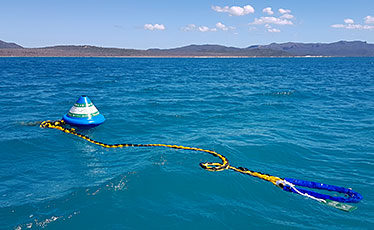Navigating the Whitsundays on a bareboat charter offers an unparalleled experience of pristine waters and stunning vistas. It is on of the most highly visited regions of the Great Barrier Reef. The Whitsundays Plan of Management is in place to help protect the reef. Public moorings are available to all Reef users and are installed at popular locations to protect the fragile reef.
Among the key skills for a sailor and their crew is mastering the art of picking up a mooring. Here’s a comprehensive guide on mastering the art of picking up a mooring in the Whitsundays.
Understanding Mooring Basics

Mooring provides a safe and convenient way to secure a vessel while protecting both the boat and the surrounding environment. In the Whitsundays, these designated mooring sites are strategically placed near popular snorkeling and diving spots, offering easy access to coral reefs and marine life while minimizing human impact on fragile ecosystems. By using moorings instead of traditional anchoring, boaters can enjoy the region’s natural beauty responsibly, contributing to the long-term preservation of this unique marine paradise.
Preparation: Know your Boat and Surroundings
Before approaching a mooring, familiarize yourself with the boat’s maneuverability, considering its size, engine power, and handling characteristics. Assess the wind, currents, and any potential obstacles in the vicinity, like other boats or underwater hazards.
Approach Techniques
Approaching from downwind or down current
Aim to approach the mooring from downwind or down current, allowing the boat to naturally drift towards it, making it easier to approach it to pick up.
Communicate with Crew
Assign specific roles to your crew. One person can be responsible for handling lines while others assist with indicating or calling out the distance from the mooring.
Slow and Steady
Approach the mooring slowly, keeping a watchful eye on your speed and direction. It’s better to drift towards the mooring slowly using the engines between neutral and idle than to approach it too fast. If you approach it too fast, you overshoot it and make it impossible for the crew to pick it up. Remember; boats don’t have breaks and reverse is not the answer either.
Executing the Pick Up
Positioning
Approach the mooring buoy on the leeward side (away from the wind) to minimize the wind’s impact. As you get closer, prepare your crew to grab the mooring lines.
Securing Lines
Use a boat hook to catch the mooring line or buoy. Have a crew member ready to secure the line to the boat’s cleats once caught.
Tips for Smooth Sailing
Communication is Key
Maintain clear communication among the crew. Use simple, precise voice commands to ensure everyone understands their role.
Practice Makes Perfect
If you’re new to mooring, don’t worry if you don’t master it the first time. Be patient and remember that everyone has been in the same boat as you are (pun intended) at some stage in their boating life.
After Securing the Moorning
Double-check the mooring line periodically to ensure it’s correctly attached and won’t come loose. Once secured, shut off the engine and any other running systems.
Respect the local environment, regulations, and other boaters. The rules around mooring use ensure they are available for everyone. Adhere to the two-hour daytime limit. It’s about fair play and anyone found to be misusing a public mooring may be issued with a fine.
YouTube Video – Mooring your boat
P
